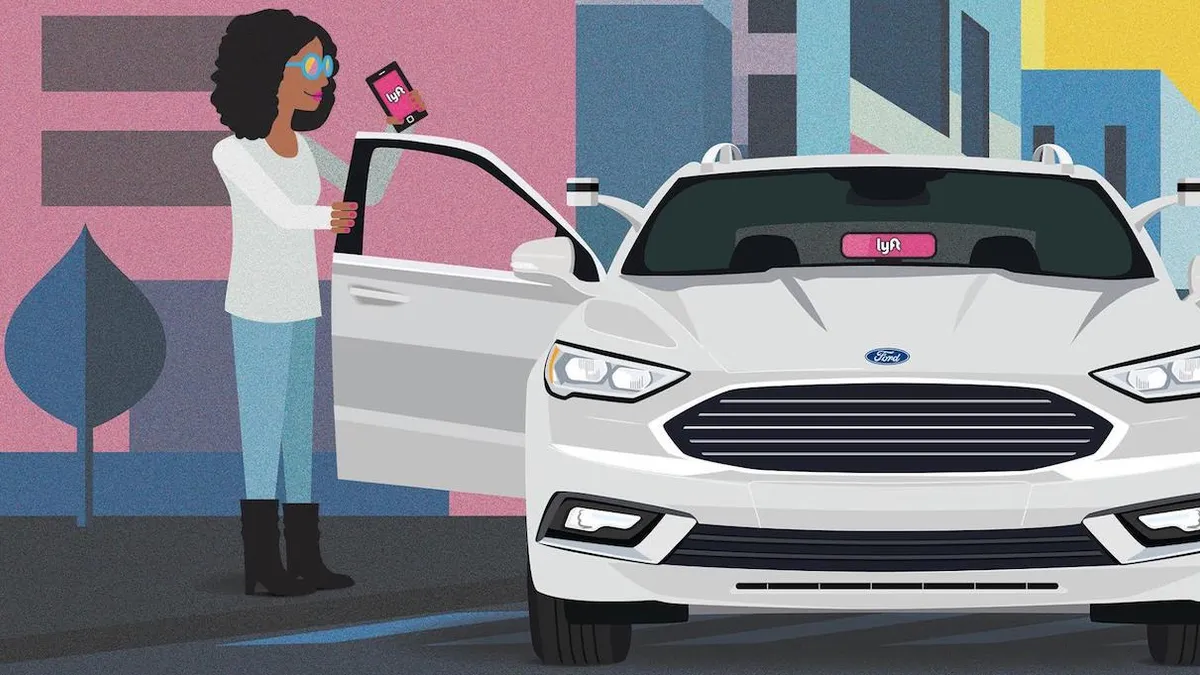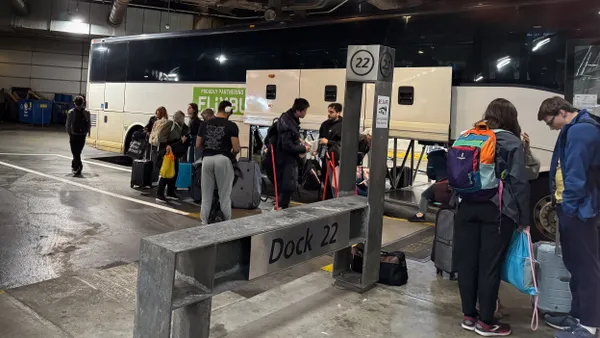Dive Brief:
- A new report by Schaller Consultants contends that app-based ride-share services contribute to traffic instead of reducing it. The report says this shared mobility trend adds 2.8 new vehicle miles for every 1 personal vehicle mile removed, resulting in a 180% increase in driving on city streets.
- Ridership is most concentrated in dense urban areas. In fact, 70% of Uber and Lyft trips take place in just nine U.S. metropolitan areas: Boston, Chicago, Los Angeles, Miami, New York, Philadelphia, San Francisco, Seattle and Washington, DC.
- Report findings indicate that ride-share competes more directly with public transportation than with personal vehicle ownership. 40% of those surveyed in large, dense urban areas said they would drive or take a taxi for their trips if ride-sharing weren't available, whereas 60% said they would have taken public transit, walked, biked or not made the trip.
Dive Insight:
This report shows that the ride-share industry has nearly doubled the size of the for-hire transportation sector since 2012. Ride-sharing accounts for 90% of for-hire transportation trips in eight of the nine largest U.S. metro areas — excluding New York — while taxis serve slightly more customers in suburban and rural areas, as well as New York.
The report implicates a social and economic divide among ride-share users and non-users. Use is highest among customers who are relatively young (25-34), well-educated and affluent. Just the fact that the ride-share apps are designed to be used on a smartphone with a credit card highlight the divide because some low-income residents do not have a smartphone and/or a credit card.
The report suggests that cities should make policy decisions to reduce traffic, such as making public transportation and biking more attractive than personal vehicles and ride-sharing from convenience, reliability, cost and speed standpoints. Suggestions include implementing policies to limit parking or banning low-occupancy vehicles from certain streets, possibly at different times of day; increasing ride-share and taxi utilization rates so the vehicles spend less time vacant; and ensuring frequent and reliable bus and rail service.
Interestingly, the report author drew parallels between what's happening with the ride-share industry and what could happen in cities when autonomous vehicles (AVs) become common. AVs are widely considered a natural fit for integration into the for-hire transportation industry. Similar to the ride-share model, a number of manufacturers are advancing AV uses for on-demand services like deliveries, such as Ford testing AV delivery services in Miami. Policy interventions are important to prevent more cars on the road, more traffic, less transit and less equity and environmental sustainability, the author says.
The study concludes: "Without public policy intervention, big American cities are likely to be overwhelmed with more automobility, more traffic and less transit and drained of the density and diversity which are indispensable to their economic and social well-being."
One red flag about the report is that actual data about ride-share trips remains a bit of a gray area for the industry. Findings were based on "published reports and news articles and newly available national travel survey and ride-share trip data that have become available over the last 18 months." The report presents ride-share trip numbers for the entire United States and metropolitan areas, noting that "[e]stimates of total trips are based on 2017 ridership reported by Lyft."
While going directly to a source like Lyft certainly is better than relying on outside estimates, more players exist in the ride-share space than just Lyft and drawing conclusions for the entire industry based on one business model might not provide the most accurate results. The report also cites ride-share data provided by big cities, but ride-share companies notoriously have battled with cities like San Francisco over withholding data about business operations, including trip data and driver pay information. So while the report provides solid guidance on overall industry trends, perhaps many of the concrete numbers would better serve as rough estimates than hard-and-fast baseline data.
Despite all the traffic- and equity-related negatives that the study uncovered about ride-share services, there were some positives like filling transportation gaps. Another positive: One of the top two reasons survey respondents use ride-share services is to avoid drunk driving. In this regard, ride-sharing could be having an impact on boosting roadway safety.












